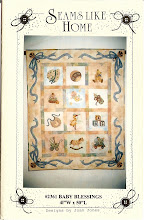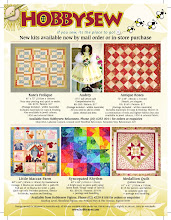On the third Monday of the month we hold a free layer and baste class. I always start the class with a walk through our wadding corner in the classroom.
There are so many different waddings/battings available that beginner quilters can feel overwhelmed so I try to describe what you will need from a wadding and which wadding will meet the needs. As I have just run through it all this morning, it is fresh in my mind so I thought I'd try to write it down in an orderly manner!
Are you doing "show off" quilting? Wadding comes with loft. The difference in the height of the wadding as it stands normally and then when squeezed between your fingers is the loft. High loft will give your quilting more definition and low loft will give it a flatter profile. High loft tends to be less dense and low loft more dense.
Washing. Some waddings shrink. Some are easy care, throw-them-in-the-machine and others need hand washing. Some need pre-washing before quilting.
I prefer to do the "worst case scenario" to my materials before I assemble the quilt. That way if they fail the test, I have not wasted my time and effort along with my money!
To pre-wash, fill the trough next to your washing machine with warm-hotter water and hand agitate. Lift gently from trough and into the washing machine to spin out the excess water. Hang on the clothes line by draping over several lines. Do not let the whole weight of the wadding and water hanging from one line on the clothesline. Poly waddings do not, in general, need pre-washing except for health reasons.
Bed or wall. Soft finish for beds to snuggle in the cold and firmer for art to hold it square on the wall.
Who is it for? At both age extremes washing and use can dictate the wadding. Easy washing in nursing homes is important and midnight washing machine cycles on Johnny's "nye nye" means you may need it to survive the dryer. Open fires in the home might steer you to a different decision.
Fire: Wool is resistant, cotton burns cleanly and poly is a disaster. If open flames are a consideration then that will guide your choice.
Ease of use? Some of the Pellon products come with the capacity to be ironed on without needing basting.
Some waddings used to beard. That is when the fine fibres of the wadding get pulled through from the middle to the quilt top making an unsightly fuzz. I haven't heard of this happening much lately as brands become more accountable. Even so there are some types that have taken extra measures to combat bearding such as Bond Tight which is available by special order.
Some waddings need more quilting.
You also need to be aware that if you are going to hand quilt, the choice of wadding will be crucial to a happy experience.
Cost. You have to weigh up whether the use it is going to get warrants the expense.
So what have we got?
We have a needlepunched poly. (needlepunching process is to reduce the chance of bearding and to keep the wadding stable after quilting and not break apart and form clumps. It comes in two widths, 115cm and 250cm, and is budget priced. It is a bit stretchy around the edges but settles down with a pat. Unbeatable value. I use it regularly in quilts that are just for fun and not heirloom-status.
Quilter's Low Loft is well priced. It has a low profile but will still offer good definition to your quilting. It is fully machine washable and does not shrink nor need pre-washing. It is firmer wadding and would suit wall quilts.
Cosy Cotton is lovely and soft. It feeds through the sewing machine really well as it squishes in and through the c-section of your machine. It is dense and heavy so if you are prone to sore shoulders you may prefer to use the wool.
Once quilted it is immediately gorgeous to wrap around you as it drapes really nicely. The cotton will shrink by 4% and must be pre-washed. Buy 105cm for every metre you need. It is a much safer fire option that then 100% polys. This is my personal favorite.
Nu Wool is a blend of wool and poly. It is dense and firm when it is new. It makes an ideal wadding for wall hangings as the firmness helps hold it flat and tidy against the wall. With use though, it quickly softens until you can not tell whether there is wool or cotton in the quilt by its draping. The firmness means that quilting is less easy as far as fitting it through the C-section, but on the other hand, it is lighter and less tiring to maneuver.
In addition to these we have three Pellon products. Pellon is dense and stable and a high quality product. Many ladies use it behind their stitcheries and stitch through all layers to give the stitching better definition and quilting it as they go. It comes in one thickness as a sew-in products and in two with the iron-on capacity.
Well! I can imagine I will be back to edit this as there is so much to say about waddings, but this will do as a start!
Monday, October 15, 2007
Subscribe to:
Comments (Atom)















